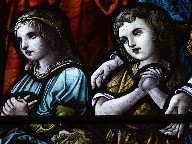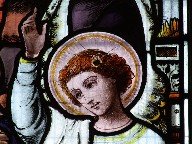| |
|
 |
|
The onset of hypothermia is
an unsettling experience. Despite my
natural inclination to exaggerate
discomfort, the real thing is something I
have only experienced twice in my life.
Once was in the frozen waste near
Leningrad as an impecunious student in
the cruel winter of 1985, as the
temperature plunged to minus thirty
degrees outside of Pavlovsk. The other
time was in Wickham Market. It
was the day of the Suffolk Historic
Churches bike ride, back in 1998. I'd set
off in sunshine from Felixstowe that
morning, in high hopes and a Celtic
football shirt, but by lunchtime a
tremendous thunderstorm had rolled in
from the sea, drenching the east of the
county. I could have stopped, I suppose,
but I was determined to break my record
for churches in a single day. By early
afternoon I was so wet, so utterly soaked
to the skin, that, like Macbeth with the
blood, it was as easy to go on as to turn
back.
|
Sixty
three churches after leaving the coast, I arrived
in Wickham Market for the sixty fourth, tired,
reasonably happy, and very, very wet. I had a
quick look in the church and got my form stamped.
Given that I had just visited 63 other churches,
and my camera had run out of film long since, it
is not unreasonable that I don't remember a whole
lot about it. What I do remember is sitting in
the market square across the road, waiting to be
rescued by my long-suffering and saintly wife.
This was when the shaking began. My body began to
do a kind of shaky dance as I struggled to
control it; I started to sweat, and my peripheral
vision began to blur. Never again would I cycle
any distance without a thermal jacket in my
paniers.
I
have been back on occasions since, and it was a
delight to return here again in 2011 on a
gentler, fairer day, when the wisdom that comes
with age banished all thoughts of breaking
records. You enter through the porch beneath the
tower, which stands to the south of the nave.
This is quite common in this part of Suffolk, but
what is unusual here is that the tower is
octagonal, all the way to the ground. The
octagonal tower slenders into a splendid lead
spire, with a bell on the west side that is
probably not in its original place. Indeed,
Mortlock wondered if it had come from the
magnificent sanctus bell turret on the
east gable end of the nave. The shape of the
aisles adds to a sense of clustering, familiar
from Rickinghall
Inferior. To your right is a pre-Reformation
red brick Tudor aisle, built as
a chantry chapel to Sir Walter Fulbourne. The
wall plates of the beams have figures on them
that might once have been angels, but they are
vandalised, or restored badly, I'm not sure
which.
Opposite
is a 19th century north aisle, which you
won't be surprised to learn is the work of Edward
Hakewill, who had a thing about north aisles. The
view to the east is most attractive in a Lavers,
Barraud and Westlake kind of way. There is a
restored set of sedilia and piscina in the
south wall, and curious chancel aisles, which
must have served some purpose.
I
have always liked the sentimental
Victorianisation of this church. Above the
chancel arch is that quote from the Book of
Genesis, more usually found outside over
doorways: This is the House of God, and this
is the Gate of Heaven. There is something
similar at neighbouring Pettistree. Beyond,
the reredos is a
delight, all gorgeous gilt and Art Nouveau
fluidity. Come back into the nave, and take a
look at the pulpit with its relief of St John the
Evangelist, surely by the same workshop as the
reredos. I think it the best of its kind in the
whole of Suffolk.
Tucked
away in the south aisle chapel is a curious 19th
Century convex brass inscription remembering a
charity donation remembering the gift of the
sum of fifty pounds... directed to be invested
and the interest therof to be laid out in the
purchase of bread to be distributed at Christmas
or such other times as the minister and
churchwardens should think fit, amongst the most
needy of the poor of the said parish, preferring
those attending Divine Service in this Church,
the last clause no doubt a safeguard in this
strongly non-conformist corner of East Anglia.
| As I write this, All Saints
is preparing itself for a major
reordering. A kitchen and meeting room
are to be built at the back. The
Victorian benches will go, to be replaced
by modern chairs in the half-round which
will accentuate the openness of the space
between the two aisles. Such reorderings
are often controversial, and there was a
vigorous debate going on in the visitors
book between those who deplored it and
those who wanted it to happen. Looking
at the plans, I must say I thought it
looked excellent. It will have a far less
deliterious effect on the church than
Hakewill's restoration did, and it will
ensure the continued use of the building
by this evangelically-minded congregation
for decades to come. I look forward to
coming back and seeing it.
|
|
 |
|
|
|

